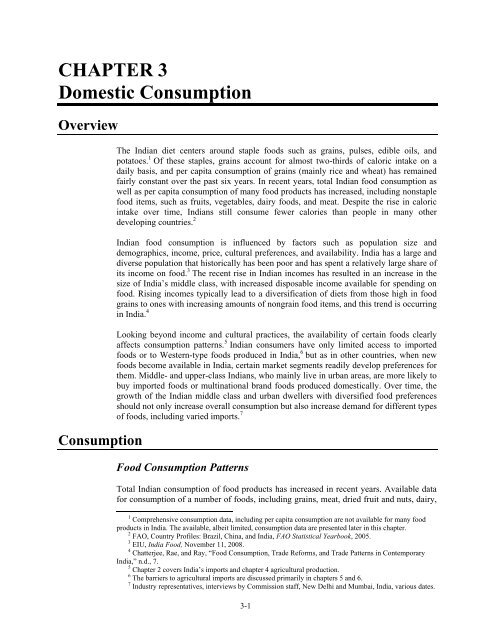India: Effects of Tariffs and Nontariff Measures on U.S. ... - USITC
India: Effects of Tariffs and Nontariff Measures on U.S. ... - USITC
India: Effects of Tariffs and Nontariff Measures on U.S. ... - USITC
Create successful ePaper yourself
Turn your PDF publications into a flip-book with our unique Google optimized e-Paper software.
CHAPTER 3<br />
Domestic C<strong>on</strong>sumpti<strong>on</strong><br />
Overview<br />
C<strong>on</strong>sumpti<strong>on</strong><br />
The <str<strong>on</strong>g>India</str<strong>on</strong>g>n diet centers around staple foods such as grains, pulses, edible oils, <str<strong>on</strong>g>and</str<strong>on</strong>g><br />
potatoes. 1 Of these staples, grains account for almost two-thirds <str<strong>on</strong>g>of</str<strong>on</strong>g> caloric intake <strong>on</strong> a<br />
daily basis, <str<strong>on</strong>g>and</str<strong>on</strong>g> per capita c<strong>on</strong>sumpti<strong>on</strong> <str<strong>on</strong>g>of</str<strong>on</strong>g> grains (mainly rice <str<strong>on</strong>g>and</str<strong>on</strong>g> wheat) has remained<br />
fairly c<strong>on</strong>stant over the past six years. In recent years, total <str<strong>on</strong>g>India</str<strong>on</strong>g>n food c<strong>on</strong>sumpti<strong>on</strong> as<br />
well as per capita c<strong>on</strong>sumpti<strong>on</strong> <str<strong>on</strong>g>of</str<strong>on</strong>g> many food products has increased, including n<strong>on</strong>staple<br />
food items, such as fruits, vegetables, dairy foods, <str<strong>on</strong>g>and</str<strong>on</strong>g> meat. Despite the rise in caloric<br />
intake over time, <str<strong>on</strong>g>India</str<strong>on</strong>g>ns still c<strong>on</strong>sume fewer calories than people in many other<br />
developing countries. 2<br />
<str<strong>on</strong>g>India</str<strong>on</strong>g>n food c<strong>on</strong>sumpti<strong>on</strong> is influenced by factors such as populati<strong>on</strong> size <str<strong>on</strong>g>and</str<strong>on</strong>g><br />
demographics, income, price, cultural preferences, <str<strong>on</strong>g>and</str<strong>on</strong>g> availability. <str<strong>on</strong>g>India</str<strong>on</strong>g> has a large <str<strong>on</strong>g>and</str<strong>on</strong>g><br />
diverse populati<strong>on</strong> that historically has been poor <str<strong>on</strong>g>and</str<strong>on</strong>g> has spent a relatively large share <str<strong>on</strong>g>of</str<strong>on</strong>g><br />
its income <strong>on</strong> food. 3 The recent rise in <str<strong>on</strong>g>India</str<strong>on</strong>g>n incomes has resulted in an increase in the<br />
size <str<strong>on</strong>g>of</str<strong>on</strong>g> <str<strong>on</strong>g>India</str<strong>on</strong>g>’s middle class, with increased disposable income available for spending <strong>on</strong><br />
food. Rising incomes typically lead to a diversificati<strong>on</strong> <str<strong>on</strong>g>of</str<strong>on</strong>g> diets from those high in food<br />
grains to <strong>on</strong>es with increasing amounts <str<strong>on</strong>g>of</str<strong>on</strong>g> n<strong>on</strong>grain food items, <str<strong>on</strong>g>and</str<strong>on</strong>g> this trend is occurring<br />
in <str<strong>on</strong>g>India</str<strong>on</strong>g>. 4<br />
Looking bey<strong>on</strong>d income <str<strong>on</strong>g>and</str<strong>on</strong>g> cultural practices, the availability <str<strong>on</strong>g>of</str<strong>on</strong>g> certain foods clearly<br />
affects c<strong>on</strong>sumpti<strong>on</strong> patterns. 5 <str<strong>on</strong>g>India</str<strong>on</strong>g>n c<strong>on</strong>sumers have <strong>on</strong>ly limited access to imported<br />
foods or to Western-type foods produced in <str<strong>on</strong>g>India</str<strong>on</strong>g>, 6 but as in other countries, when new<br />
foods become available in <str<strong>on</strong>g>India</str<strong>on</strong>g>, certain market segments readily develop preferences for<br />
them. Middle- <str<strong>on</strong>g>and</str<strong>on</strong>g> upper-class <str<strong>on</strong>g>India</str<strong>on</strong>g>ns, who mainly live in urban areas, are more likely to<br />
buy imported foods or multinati<strong>on</strong>al br<str<strong>on</strong>g>and</str<strong>on</strong>g> foods produced domestically. Over time, the<br />
growth <str<strong>on</strong>g>of</str<strong>on</strong>g> the <str<strong>on</strong>g>India</str<strong>on</strong>g>n middle class <str<strong>on</strong>g>and</str<strong>on</strong>g> urban dwellers with diversified food preferences<br />
should not <strong>on</strong>ly increase overall c<strong>on</strong>sumpti<strong>on</strong> but also increase dem<str<strong>on</strong>g>and</str<strong>on</strong>g> for different types<br />
<str<strong>on</strong>g>of</str<strong>on</strong>g> foods, including varied imports. 7<br />
Food C<strong>on</strong>sumpti<strong>on</strong> Patterns<br />
Total <str<strong>on</strong>g>India</str<strong>on</strong>g>n c<strong>on</strong>sumpti<strong>on</strong> <str<strong>on</strong>g>of</str<strong>on</strong>g> food products has increased in recent years. Available data<br />
for c<strong>on</strong>sumpti<strong>on</strong> <str<strong>on</strong>g>of</str<strong>on</strong>g> a number <str<strong>on</strong>g>of</str<strong>on</strong>g> foods, including grains, meat, dried fruit <str<strong>on</strong>g>and</str<strong>on</strong>g> nuts, dairy,<br />
1 Comprehensive c<strong>on</strong>sumpti<strong>on</strong> data, including per capita c<strong>on</strong>sumpti<strong>on</strong> are not available for many food<br />
products in <str<strong>on</strong>g>India</str<strong>on</strong>g>. The available, albeit limited, c<strong>on</strong>sumpti<strong>on</strong> data are presented later in this chapter.<br />
2 FAO, Country Pr<str<strong>on</strong>g>of</str<strong>on</strong>g>iles: Brazil, China, <str<strong>on</strong>g>and</str<strong>on</strong>g> <str<strong>on</strong>g>India</str<strong>on</strong>g>, FAO Statistical Yearbook, 2005.<br />
3 EIU, <str<strong>on</strong>g>India</str<strong>on</strong>g> Food, November 11, 2008.<br />
4 Chatterjee, Rae, <str<strong>on</strong>g>and</str<strong>on</strong>g> Ray, “Food C<strong>on</strong>sumpti<strong>on</strong>, Trade Reforms, <str<strong>on</strong>g>and</str<strong>on</strong>g> Trade Patterns in C<strong>on</strong>temporary<br />
<str<strong>on</strong>g>India</str<strong>on</strong>g>,” n.d., 7.<br />
5 Chapter 2 covers <str<strong>on</strong>g>India</str<strong>on</strong>g>’s imports <str<strong>on</strong>g>and</str<strong>on</strong>g> chapter 4 agricultural producti<strong>on</strong>.<br />
6 The barriers to agricultural imports are discussed primarily in chapters 5 <str<strong>on</strong>g>and</str<strong>on</strong>g> 6.<br />
7 Industry representatives, interviews by Commissi<strong>on</strong> staff, New Delhi <str<strong>on</strong>g>and</str<strong>on</strong>g> Mumbai, <str<strong>on</strong>g>India</str<strong>on</strong>g>, various dates.<br />
3-1

















